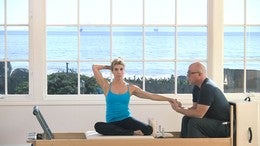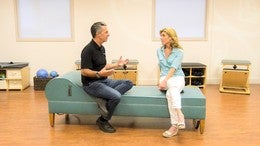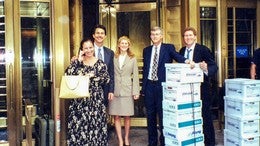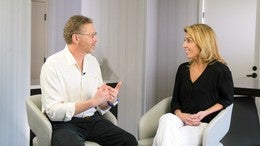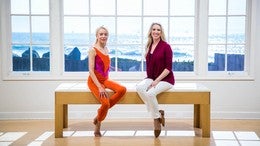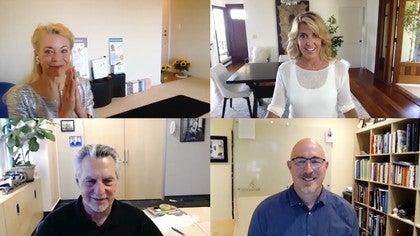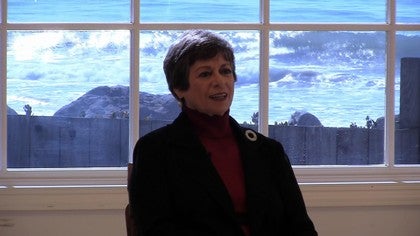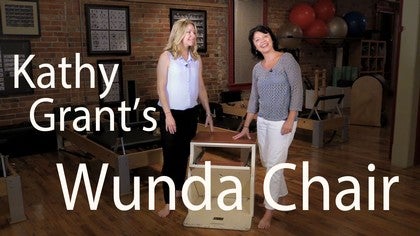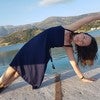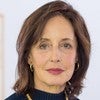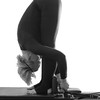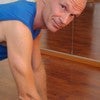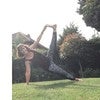Discussion #4205
Pilates Pioneers
Description
If you want to learn more and dive deeper into the rich history of Pilates, check out our Pilates Legacy Project.
About This Video
Transcript
Read Full Transcript
My guest today have shaped the pilates industry individually and collectively. We have three people here today that if you don't know already, you need to. We have Elizabeth Larkam, Ken Endelman and Brent Anderson here today to talk to us about their history with Pilates, about so much of what they've done, and I'm gonna bring it out of them so that you get to hear it too. So let me start with Ken. Ken Endelman is the creator, owner, founder of Balanced Body, formerly known as Current Concepts.
I believe it was 1976 when he was making custom furniture, and waterbeds sticks out in my mind, he was asked to make the first reformer, has been refining, advancing the equipment ever since. Not only that, but he's become a major advocate for Pilates in its preservation. That's a reference to the trademark lawsuit. If you don't know about I encourage you to look into it in a different video. And not only that, he's an archivist, in my opinion, he has done a lot of work in the history and finding out more about this man that we've all devoted our life to.
So, Ken, welcome. We have also Brent Anderson. Brent Anderson is the CEO of Pollstar Pilates, Pollstar Education, one of the largest training organizations in the world. A good friend of mine. If you've never seen Brent's work, you can look at any one of the videos that I'm in because it's pretty much each and every one, but a few specific ones.
He has transformed me on the spot, on video, without prep. And that has a lot to do with his physical therapy background, with Anderson physical therapy. And Brent, welcome. Thank you for being here, my friend. Thank you, Kristi.
Elizabeth, Elizabeth Larkam, leading movement educator in the fascia world, recently a new author of "Fascia in Motion". I'm hitting the book, but not showing you the book. "Fascia in Motion". Currently working on another book with Madeline Black, but "Fascia in Motion". This is a long time effort, Elizabeth researched with those that are researching fascia.
So she's bringing it back to us. A million videos on plates any time that you wanna check out for her wit and her knowledge. Thank you Elizabeth. Welcome. It is my great pleasure to have you all here, and I will let you all talk soon, but for now I wanna kind of just bring about the Pilates Legacy Project is my personal passion around, trying to record this oral history that we have. But then there's this other stuff.
There's this tactical stuff that you all have been involved in. And I just want people to know that. So it's a big deal for me and I really hope that people get it. So, let's just begin with some questions, shall we? How did you all meet? Like, how does...
Like we have an equipment manufacturer right now, the lead educator and then the other lead educator in fascia, but it's all... How did you come together? And I will start with Brent. Brent, will you start with that question? Yeah, I mean, I was, it was in the late 1980s. I was in San Francisco going to physical therapy school at UC San Francisco.
And I was taking a ballet class from Gail, I can't remember her last name, but she had asked me and she said, "St. Francis now has this Dance Medicine Center and they have Pilates." And I said, "Oh, they have Pilates. I never heard of Pilates." And she goes, "You should really check that out." And so, I think I was in my second year, I think probably, Elizabeth, it was like '88, somewhere around there, '88, I know '89 I graduated and I went over to St. Francis hospital and I met Elizabeth and Patrice Whiteside there and became fascinated. They introduced me to Dr. Carrick. And that was the beginning. I met... I think that Elizabeth was teaching and they were just organizing their own education at that time.
It was one of the very first of any kind of formal education that existed in the Pilates world, was St. Francis certificate. And I think I finished that in '89. And by that time I had moved to Sacramento, graduate from PT school. And Elizabeth introduced Ken to me and said, you know Ken is in Sacramento and my hometown was Sacramento. And by 1989, we were buying equipment for the first physical therapy office there in Sacramento.
And we just started doing more and more things together and pretty soon we formally organized. I, Ken and I were just talking about this a little earlier, just trying to get our facts straight. And I know Elizabeth helped me with my facts last time, 'cause I was trying to remember, what year was it? How did we meet? What happened? But I'll tell one of the stories that sticks out in my mind is I knew that when I came in to the Dance Medicine Center, so like, okay, here comes a physical therapist, and there was sort of an interesting energy.
Remember, Elizabeth, how like the physical therapist really weren't allowed to really come into some of that dance medicine space unless they were dancers or they had the Pilates background. So I could feel there's a little bit of, like, if it comes out a physical therapist, and one of the first exercise, I don't know if you remember this, Elizabeth, you gave me, was getting onto the box on the reformer, on my pubic bone, with my feet on the foot plate, going into swan, reverse swan on the plate. And it was sorta like, if he does this then we'll continue the discussion. And so I did everything I could to do, but it was at that point on that we were sort of inseparable. I mean, I think we started doing, I think, in 1990, in '91 we were already teaching different workshops and lectures and different conferences together.
What I haven't said so far is that the reason this came about is they have all these photos and memorabilia that maybe they can show along the way. I don't expect that now, but as we go through stories, we're gonna hear them and then maybe later see some of the photos around it. So, thank you, Brent. Elizabeth, you wanna talk about? I'm happy to yes, of course. And to give a little background with some photos as well just so people have the background.
So, St. Francis hospital, a large hospital in downtown San Francisco. In 1984, Dr. James Garrick, an orthopedic surgeon, an MD, orthopedic surgeon, was invited to found the Center for Sports Medicine, which was a novel thing to do in a hospital setting. And Dr. Garrick had the vision that he wanted, not only to treat dancers, but ice skaters and football players and soccer players and equestrians and triathletes and Dr. Garrick founded this phenomenally comprehensive center for sports medicine with the dance medicine division. He knew about the dance medicine area. He knew about dance medicine, because he went to a conference in Los Angeles where Diane Severino was teaching.
Dianne Severino and Michael Podwell were assistants to Ron Fletcher. Ron Fletcher, the first-generation Pilates teacher who brought the Pilates work from New York, where he worked with Joseph and Clara, to Los Angeles. So when Dr. Garrick met Diane Severino demonstrating a Current Concepts reformer in the hallway of the dance medicine area, Dr. Garrick knew that he had found something that would help him treat dancers, because Dr. Garrick knew that dancers were racehorses and workhorses. And when they were injured, they would not stop. He knew that he had to give the dancers a substitute activity.
So Dr. Garrick founded the Center for Dance Medicine with Patrice Whiteside, and together they contacted Ron Fletcher to ask if Patrice could be trained by the Ron Fletcher company, by Michael and Diane. So Patrice got her background in the Ron Fletcher company, the Ron Fletcher Pilates and Patrice, together with Dr. Garrick, then ordered the equipment from Ken Endelman. And one thing leads to another, as it always does. Patrice, I was Patrice's student and a student of Michael and Diane's of the Ron Fletcher company. I came as a self-referred conditioning client to take care of, not a dance injury, but a soccer injury that bothered me from, when dancing.
And then when Patrice could no longer manage all of the interests, all of the clients, the patients who were crammed into the medical records area in the basement of St. Francis Hospital, Patrice and Dr. Garrick invited me to join the staff to be, what they call, the dance medicine Pilates specialist. So then we moved upstairs to the second floor. We had more space, but we really didn't have any outdoor light. And one thing leads to another, as it does. And Patrice and I noticed that there were of a number sports medicine and dance medicine universities and clinics that wanted training in the techniques that we were doing.
So we started an education program, which brings us to the topic of the day, which is that in 1989 I sent a letter to Brent, inviting Brent to participate in our five day... Five days. That's what we knew at the time. Our five day program in what was the Dancemedicine Division Center for Sports Medicine training program in rehabilitation and conditioning exercises, utilizing Pilates apparatus. Now, Brent, I'm not sure that I can really go along with your first exercise memory, excuse me, balancing on your pubic bone... It could be a fantasy of mine.
We can always relive those fantasies because this says Monday, December 4th, 1989. You had your introduction from 8:00 to 10:00 AM on the reformer and trapeze table. And then from 12:30 to five it was leg and foot exercises using the bar and platform. Now, another time you and I can go over this calendar and I'm sure we'll find that swan on the box. I'm just positive.
I think we met and we talked before that day. But it was not the actual training. It was my first exploration of Patrice Whiteside. And you at the center there. I sit corrected. You are right.
Wow. You got it. That's awesome. And it might not have been the reverse swan on the box. It might've been something else, you know. (everyone laughs) Ken, I want...
Really fun, all of that. Ken, how did you end up there? You were, I kinda know the original 1976 making the waterbed, but you're now at St. Francis, how did that happen? Or how did you meet? How did I meet?
So it came to Danny Severino and I got a call from Diane and she said that she was training some people at St. Francis hospital, your know, at St. Francis twice, I just knew that it was in San Francisco. I was excited that there was gonna be some Pilates in Northern California. I was really excited that I didn't have to drive five hours to deliver equipment. And I was excited that it was going into an institution. So I actually made the delivery, drove it out to San Francisco, and that was, and I had to find a place, I had to park, you know, it's like, I was really comfortable being in Sacramento.
Now I had to be in San Francisco. I finally knew where to go. And we brought the equipment in there. And it was at that point that I met Patrice. And at that point, I really wasn't so much aware of the significance of what was happening.
I knew that this was not just a Pilates studio. I knew that it was a real hospital. I knew this was something that was real and it was very different than other Pilates studios that I'd been into. And with different protocols and everything. And I was walking into a hospital not to visit a patient or not for my own reasons, but actually it was like...
I felt really kind of official. So it's actually part of this organization and doing business with them. So I made a couple of trips to deliver equipment to St. Francis. And then I think it was '88 or '89, Elizabeth. And you guys had the guest events and conference there?
'88. The Professionals Forum. Yeah. And it was a really cool event. So I showed up there and they were like heavy hitters. So there was Bruce King, Eve Gentry was there, Ron Fletcher was there.
Not Carola but Kathy Graham was there. And this is like the first time that, first of all, I've seen a lot of these people, I had already met Ron, but I'd seen a lot of these people that were, at that point, still legends in the Pilates world. And it's the first time I met Elizabeth, and Elizabeth was, you know, she was just excited to meet me and she was energetic was and she warm. And so, that was kind of really important to me because at that point, I always felt like kind of an outsider to the Pilates world. Like, I'm just the equipment guy. I'm not really the...
I'm not really the Pilates person. Right? (Kristi laughs) So you guys, can you, seriously, I have to, but you guys- You were always the Pilates person to me. You all had, not you all, but everyone needs to know what this man has done. For him to say that it almost takes you to your knees, but okay. Carry on, Ken.
That's how I met Elizabeth. And then in 1989, we were doing our first catalog and this is kind of a small version of the catalog. And it's got, I'll actually send you the copy of this, it has got a picture of St. Francis on the back. And it had, like, endorsements, you got a picture of Joe in it and stuff. At that point, I had a part-time marketing person.
Her name was Wendy Heatnes. And Wendy said to me, "Well, Ken, you know, it would really be cool if we could actually say that you do Pilates." And so I had taken Pilates classes up until that point, but I never really wanted to really familiarize myself with the equipment. So I set this deal up with Elizabeth at St. Francis where every Thursday I drove to San Francisco and I stayed there until exactly 2:30 so I could beat the traffic home. And I spent two to three hours and they just beat the hell out of me. And they would put me through the exercises and every piece of equipment.
And like, they would kind of treat me like a, you know, they teach me how to do it while I was learning. But like, at least at that point, I wanted to learn every function of each piece of equipment. And it was really helpful because I was building that. Right? So it was important. It's important.
Were you on your equipment when you were learning it that way? Yeah. I was gonna say, what else did we have? And then they closed the loop right around that time, I think it was also an '89. I get this call from Elizabeth and there's this guy named Brent Anderson.
And he's from Sacramento and, you know, he's been a good student and, you know, you really should meet this guy. And then I'm thinking, wow, you know, I think now I got somebody in San Francisco. This is gonna be the first Pilates thing in Sacramento. Right? And you have to remember that, you know, like, in 1990, there was maybe 128 people that I knew of in the Pilates world and maybe 120 that I didn't know of.
So now I knew two in Northern California which is a big deal. So then Brent calls me and says, hey, I'd like to come over and meet you, and see your shop. And I'm thinking that's really cool. And I don't know if I was late in coming back to Current Concepts at the time, where you were early, knowing us both we were probably both late, but probably, you know, maybe not, but and then Ben's walking out. He's like he was actually walking out of my shop.
And I'm walking back, I think, for lunch. And that's how we first met. And then we started talking about equipment and that's kinda how I got to meet both of these guys. So, from someone over here, I have all these stories I want say about how I met you all. But what I wonder is what made you need to meet each other?
You were introduced by so-and-so and Brent's now walking through your doors. Like, what made you do that at a time when nobody, not nobody but most people weren't really going down the road of I'm gonna do Pilates forever. Like what made you do that? And I'll throw it to anybody who can jump in on that. So what were we thinking, you guys? What were we thinking?
You kind of, because that's where the gratitude comes in. That's where that thing was safe. That's where there's some nugget, and maybe it's not the right time but it's very interesting that the three of you did all that in your own individual ways, in big ways, making equipment, you're doing, you start the thing together, whatever, it, just how did I get so lucky that you three did that? Because I now have a business because of it? Well, my answer is simple, but you guys can start.
I mean, I'll take a shot at it. I mean, I had just finished, you know, my professional training. So I was in that sort of evidence-based mode, but I had this quote to the Pilates that I felt at St. Francis was off the charts. I mean, it was, it wasn't in the evidence-based era yet. And Dr. Garrick took a huge risk to bring it into the medical profession.
But I think, straight off the bat that was our commonality for Elizabeth and I was talking about, and maybe indirectly, Dr. Garrick was looking and saying, like, how do we bring this to the profession of rehabilitation in particular? At those times we thought it was primarily dancers and athletes, but very quickly realizing that it was anybody with a pathology that wanted to move was somebody we were interested in exploring. And we just were asking the questions and it was the right time. It was a perfect storm. It was... The popularity of Pilates in LA was starting to rise and become, you know, sort of a cool thing and a chicy thing.
And we were just really interested in the science and the education and the quality of the equipment. And we all three had our sort of drive. It was a perfect storm. Its just the timing. I mean, if we'd gotten together 10 years later it wouldn't have been significant. I understand that.
I feel like, I say the same words about me, John and Ted who are my partners, and like, how did that work out? But did you have any sense, any one of you, that... Kristi, I'd like to answer that question. Yeah, please. Yeah, sure, sure, sure. My turn to come up with that one.
Yes. That, I was really drawn to the St. Francis Hospital. I mean, to the dance medicinary, to Pilates, I never knew that the Pilates, that Pilates existed as a profession, because it didn't exist as a profession when I was going through Stanford as an undergraduate or even as a graduate student. But when I got there, I just thought, oh, this is what I've been preparing to do, to use movement for healing, using this gorgeous equipment that's like a jungle gym for adults. And it was amazing to me that we even got paid.
I mean, which we did, but I would've done it anyway. And the fact that there, as to carry on with what Brad was saying, the fact that there was the interdisciplinary mingling was just part of the aquarium we were swimming in. With physicians and surgeons and physical therapists and athletic trainers and sports psychologists and dancers, even better, dancers. Movers. Yeah.
Ken, I know you said you had a, just, please. I wanna know your answer too. It's always really funny 'cause you look at all the important and critical moments of your life and while you're in the middle of them you just think it's just more, it's just more stuff. Right? And then you look back and you think, wow, that was really a big deal.
And all I was trying to do at the time, I was just trying to control the chaos and fall forward and be constructive. And so I didn't really know that it was a big deal. I just knew that, and this is kind of that '88, '89. That was the time after making Pilates go for 14 years. And by the way, still mooching off my wife, that I realized, there really could be a future here.
I mean, this could really be a thing. Because up until that point, it was just really slow and not much has really happened in the Pilates world. And all of a sudden we're starting to see, I'm seeing, I'm seeing St. Francis hospital, I'm seeing Pilates growing. I'm seeing a huge amount of media attention right right around that time. And I'm seeing it go globally.
I'm having international customers. And I'm thinking at that point, it kind of clicked, okay, this is something that I wanna grow. I wanna pursue. I wanna nurture. And then, this is really kind of practical, but for me not being a Pilates person, and I consider myself a Pilates person, I needed to have partners that could walk the walk and talk the talk and understand how to communicate Pilates to the world. And that's what Brent and Elizabeth did for me, and for us, actually, is they were kind of the communicators with the world.
They were executors. Thank you. I was gonna say anything about Ken is that, you know, he wanted, he knew that the equipment could be better. Like he always knew the equipment could be better, and he was always searching. And I think that was, you know, it's like all of us were searchers.
Elizabeth was looking at all the education, wanting to know from as many of the elders as possible. I mean, literally study with every elder. You know, it was like trying to find the answer and we all have this holistic aspect to us as well, which was another thing in common. Like we didn't want necessarily revert back, just the healing side of medicine, not the pharmaceutical or those kinds of things, like it was really about healing, loving, learning kind of things that we all share is our own philosophy in life that brought us together. But I was gonna say Ken was always asking the question, like what would make this more mechanically, a better mechanical advantage?
What would make this accessible to somebody in a wheelchair? What would make this if it was like, well, raise it up to a higher frame level so that we can have a reformer that somebody could transfer to. Well, what about the foot bar? Yeah. Well, let's make a foot bar that can accommodate a child or somebody with one leg or different heights that weren't available at that time. And I remember a discussion, and we were with Ramana and Steve Jardano in San Francisco and we were there talking to them and meeting with them.
And I probably overstepped my bounds but, I remember getting a little bit of a discussion about, look, high back arch for Steve is not the same as high back arch for Brent. And if you want me to have the same experience that Steve Jardano's having on this exercise, Kenny has to make equipment that has wider shoulder pads and a bit little longer footplate, a longer base. And that was to me was very interesting is, Ken just listened. Like he always was thinking like, I can do that. I can make it adaptable.
I can make the shoulder pads work for somebody with narrow shoulders and wide shoulders. I can make the foot bar adjustable. And it was just that ability for us to enter into a market that made, really, I think one of these, we made Pilates available to a large population by seeking to understand rehabilitation and push rehabilitation in performers and a much broader population of people that could benefit from Pilates. Absolutely. I cannot believe how much time has already gone by.
So, but I love that. And I'm gonna add to that. Brent, Ken may not know this, but you came to our little studio in 1995 and did exactly what Brent was... Maybe six, Maybe six somewhere in there in Santa Barbara. We had Jim's studio and you came in and you're like, what's up?
How's it going? What do you need? We had to, you know there was four of us in this 8 by 10 room and we're like, what do you think we need? We didn't know at that time but the long and short of it was I get what you're saying, Brent, that he listened and in the, and I'm gonna add to it, Ken, sorry, you always tell me to stop. But when we opened our studio and theoretically could be considered competitors, you and Al and everybody show up for our grand opening of the studio, and you gave me that advice that you've referred to even today is, you know, when you fall, fall forward. And that's, it's been a great thing for me to go, right?
You have to listen and you're gonna fall. And when you do, fall forward. And so I just want you to know that again if you haven't heard that from me before. And so, but I do think that that matters. And I, a question for all of you is, did you set out with any intention to replicate what you hear Joe said, that the whole world will be doing Pilates and he was universal for world.
Were any of you trying to make sure that that happened or were you just seeing the actual results and you wanted to make better equipment, you wanted to know more research and you wanted to be able to put it into physical therapy. Like, any one of you can answer that? And all of you, please. Yes. I found that I didn't need to, it's almost, if I didn't consciously need to set that intention, because the whole world seemed to be coming to St. Francis or to the exhibits or the trade shows where we were, seeming to be asking.
So we were so fortunate, as you know Brent and Ken said, we were so fortunate. We had meeting, a course with Carola Trier in Southern California in 1989, 1989. And the entire Dancemedicine Pilates staff went down to study and with Carola, and with Carola and Michelle Larson was there with Carola. All of us were there and it was just, it was a reinforcement or an indication that our worlds were coming together. The worlds that we're interested in, sports medicine and dance medicine, and physical therapy that met at St. Francis hospital, were intersecting with the broader Pilates community that brought the word from Joe.
I was gonna say, the cloud- One thing about that 'cause Brent was here. I was there. I think it was the first conference I actually attended and participated in and I had to figure out what to wear and Brent gave me instructions on it. What is it called? The dance belt? I had to wear a dance belt. My first experience- (Kristi laughs) I won't say anything about it. I'll leave you guys- (Kristi laughs) Fantastic. How was that, Ken?
Well, I never wore it again. (all laugh) I was gonna say something that the clout that Elizabeth carried from St. Francis opened up so many doors and, you know, we basically presented at every conference. I mean, it was never, we applied and we presented, I mean, there just wasn't a conference, California Physical Therapy, IADMS every year, National Physical Therapy Association, Ursa, club, I mean, there just wasn't a place that, we were always teaching, and it wasn't like we were just going and renting a space to be an exhibit hall. Like Elizabeth and I would be featured presenters in these meetings and it just was continuing. So there just was this craze in our profession, you know, what would you say?
Even through like '97, '98, there was just this craze, that we were on the road, the three of us, continually, going to conferences and being keynote speakers and guest speakers and presenters and courses. And I don't think we had our own first course, when was the first course that we actually offered, Elizabeth? I know you had that flyer. Was it like 92 or 93? I think it was 92. But I mean, we were just going everywhere and we also had the privilege of, you know, going throughout the workshop, the Romana workshop, Eve Gentry in Santa Fe and Jean-Claude West in New York at that time.
We just had a chance to be with amazing people. Yeah- The footwork of Eve Gentry I see up there. Yeah. Oh. and we had such a great time in Santa Fe. I mean, that was probably one of my highlights with an elder was when we were all there with Eve.
One of the questions I kind of prepped you all with was how important was St. Francis. And I get it, basically. I know there were more people that went there and out of that, they ended up in Santa Fe or other places. Can I add one thing, Kristi, about St. Francis? Yeah. That was important for me
was that the thing about St. Francis was up until the time Saint Francis came along there really wasn't any real medical institution that was behind Pilates. And so people would always ask, where's the science? You were always treated like it was a fad, and then when St. Francis brought up Pilates, all of a sudden, it's like, oh, this is a real institution. They do real medicine. This is a real hospital. This is a great thing. And that in itself replaced a lot of the questions that asked for research.
Yeah. Okay. Thank you for that. How did you then feel later when it was definitely brought out in the magazines and that, this, like, it's only for celebrities, it's only for, how did you feel then? And was there anything, any of you could talk about? There was a time not long ago, really, that it was like, oh, it's just a fad.
It's not exercise, it's fitness. It's whatever it is. I'm not that any, just curious, like, how, did anything change for you when you knew you were getting the research behind you and you, or the hospital behind you, unlike what Joe was able to do? Like, how was that for you at that point? It wasn't a bad thing at all, for me anyway.
I mean, it was really great to get the exposure and it was really, I mean, we can talk about Pilates. So when celebrities were talking about Pilates, it really helped go to cause. So any anything that encouraged Pilates was really a great thing. Sure. The more people that do Pilates and more people have discovered it and, you know, and that just moves the industry.
That's exactly how I feel. Yeah. Any publicity is good publicity, right? Yes. There was no, that I remember, any really bad publicity, even, you know, even twisted that were out there at the end of the day helped us.
So I can't complain. Okay. That's great. Great to hear. We were so fortunate because since Ken had the world's best and largest Pilates equipment manufacturing company, he would get requests for photos. So Lears, which is now out of date, but I mean, and out of print, but I remember that Ken got a two-page spread in here with, one of his, it was your equipment innovation, Ken.
The tubular steel studio reformer, the teaser. Yeah. Yeah. And I had all these stock photographs already that we took. So I've got a couple of years.
I was just gonna say, let's get into photo. Tell me more because I probably gonna recognize them and I'll probably cry, but go ahead. Show me. Show me. Show me. Show me. Okay. Anyway, so here's one that was from Elizabeth.
It was like, there you go.
Actually I do have, I'm looking here, That's all right, take it- I'll send them to you, Kristi, but we had Shape magazine did a giant article on us, Elle magazine did a giant article, not on Elle Sport, they mentioned Elle Sport. And then they'd usually talk to us. And then they would do photo shoots on their own. And then we also had a library of catalog shots, because lots of publications, a lot of people don't know this, a lot of computations are too cheap to take their own photographs. And it was a big thing back then.
So if you had a photograph, then all of a sudden it was really easy to get an industry to- Yeah. They're like, they'll listen to you. Yes. Yeah. Easier 'til I send. To bring it back to the Pollstar brochure. Brent, this was a, we took this photo in your physical therapy center in Sacramento, before you moved to Miami.
And it was after our weekend course, it would be a, probably a Sunday afternoon. Yeah. I love that block's long. Oh, the black column upholstery. Yeah. Yeah.
Yeah. Yeah. That's another... That was a nice color for a long time. Well, that was my color. You know, it's interesting, like you're talking about publicity and I was thinking of our late Mari Winsor, you know, when she started pushing.
And so many people were like concerned about what happens to the quality of Pilates if it's on a video and we know now how powerful it is and, you know, Pilates any time can certainly testify to pivoting on that. And there also was a time where, you know, Ken was innovating new equipment and one of the purposes was, you know, could we do group classes on the reformer? And I remember catching slack, you know, flack from different people on the idea that, you know, you can't teach more than four people on a reformer. And it's like, well- Watch me! It's only because we only have four reformers. You teach 20 people in that class.
So why could you teach 10 people on a reformer? But it was that kind of question and innovation and really testing the waters on things and realizing we were straddling the line all the time between fitness and rehabilitation. We didn't miss a fitness conference. We didn't miss a rehabilitation conference. we were looking, right?
We were looking at how do we enter it better into this market? And how do we, you know, there weren't enough studios to think that we would be busy just marketing studios. We were looking for institutions. One of our biggest was... Elizabeth was the main contract that we had for so many years.
Bally Total Fitness. Yes, Bally Total Fitness. That was a make and break for us. I mean, Kenny making lots of equipment, and we had, I think we did like 60 courses in a couple of years, Bally's, you know, it's where we built our new educators and people that we connected with, that was a big contract for Polestar and for Bounced Body. And thank goodness. I mean, now I can say that.
I remember when John and Ted were like, so are you ready to put Pilates online? Like, no. Cole, Elizabeth, Brent, and Ken. I can't do that. I'm not the one. But it's, at the same time it's like you said, one of you said, I think Brent, that once it's out there, once people get to see they get to see more, they want more, they might do more and they might find the right person.
I definitely feel like those kinds of situations have helped, maybe selfishly so, but it's a belief I have that you serve when you offer the exposure. And if it's at Bally's, or Pilates, anytime, or Pilates or whatever it is, that it's body, it's like, get people to understand that they can feel and be better. And that seems to be what you all have been doing all along. I want more stories. I have all these questions. I'm just gonna let them go for now.
And if you could just give me, like, I wanna know, here's what I wanna know. I wanna know, like the most fun memory you have together. They may not be the same, that I just wanna know that... When you're traveling, I've heard that you shared hotel rooms before, I heard that, all in the effort, it seems to me any good memory that you could share would be, because you are in effort of serving, either the research or the equipment or the actual getting, the actual method. So I would love to know, I'll start with you, Elizabeth, if you would, if you have one or anyone, but...
If, can I go? Yeah. I'm thinking we all can remember one really good one. I think I- (everyone laughs) Ken, you first, yeah. I wanna light a fire- My close memory for the three of us was in Israel, it's not gonna be yours, Brent?
That was mine. The three of us, we were at this medicine conference. IADMS, there's a good picture. Oh, you've got the picture, yeah. The Dead Sea. Yeah.
So we're at this conference for IADMS I'm and it's (indistinct) in science. I was actually scared to go to Israel because at that time there was violence there and typically is this stuff, and I was gonna go there and I was gonna stay at hotel room where I'd be safe and go to the conference, and do the Current Concept stuff. And that was gonna be it. And after about a day of that, we're sitting in our hotel room and we're thinking, jeez, wouldn't it be cool to go to Jerusalem? Wouldn't it be cool to go see some stuff?
And so Brett and Elizabeth and myself and Marica Mona, right? Marica Mona. Nuh-uh. We found a guide. That like the high school. Like, I wish I was in that.
(everyone laughs) And we find this guy, and this guy had been in every single historical event from the liberation of Israel to the, you know, all the different wars and stuff. And then he taught history. So the he was best guide in the world. And so we get into this kind of this band thing and we started driving up to Jerusalem and he starts telling us stories. And he was unbelievable, because he would like give us all the different perspectives and all the counter opinions.
And I'm just sucking this thing up, 'cause I always wanna hear the revisionist theory and what was good about this battle, and you know, and he's, and I remember one time he said to me, Ken, even if I knew the answer to that question, I wouldn't tell you, so- Did he follow with, 'cause then I'd have to- And they're taking mud baths with Rica Mona and stuff, he was just, it was just a really cool experience and something that could never ever be replicated. Right. He taught us songs. I remember today. (sings in foreign language) We were singing it in the van as we're driving along. It was spectacular.
What would have I given- It was spectacular. It sounds amazing. And that's the photo that you're showing, you're in the Dead Sea. Is that right? Yeah. Wow.
You're all just making me jealous now, but let's keep going- I remembered a lot like you mentioned, you know, I think we were traveling 20, 30 weekends out of the year already, and we didn't have any money. Most of the things we were doing, it was, we just did what we had to do. You know, it was like, you know, we had our bags and our equipment and if sometimes we drove the truck, sometimes it met us. We stayed in the, Ken and I sleeping in a King size bed and Elizabeth in the bed next to us or two queens. And we just did what we had to do.
It was like, it was never a question- Hairy legs, yes. Wait, what did you guys say? It's kind of like, when I learned that I didn't like sleeping with guys with hairy legs. Well, the good news is neither of us are extremely hairy. So that was a good thing.
But you learn how to fold the sheet so that you don't have to deal with that, but the, or Elizabeth taking, she was always super polite, but it was like, I'm gonna take a bath and I'm gonna be in there for a while. So if you gotta use the bathroom, now's the time to do it. And then we knew the Epsom salt bath would happen and we'd go to sleep and it's morning everybody was bright eyed and cheery, but we just made it work. And I always think of blessed Ken and my wife and this Ed, Elizabeth's boyfriend at the time, you know? And they're sort of like, what exactly are you guys doing?
It's like, trust that we're working so hard, we can barely see straight. We were just partners and good friends and we're working hard and saving money. Yeah. Elizabeth, I want you to answer that too, but go ahead, Ken. At least we saved money 'cause we realized that if you took a red eye flight we would save the hotel night.
We're gonna sleep in the plane, right? So, I can't help, I definitely wanna hear Elizabeth's part of this, but I also wanna know like, why, like, I mean, why did you care so much? Was it because it's like I gotta pay the rent or was it because you cared about propelling this thing forward? Or was it just because this is what, how you do it. This is how you do the thing you're doing.
The opportunity was there. We wanted the opportunity. I think we were being invited. It was an honor, the institutions that invited us. I mean, it was career building. It was business building for Ken and the manufacturing.
That was important time in my life. I can speak for myself. I mean, as far as just professionally developing and developing presentation skills and teaching skills and Elizabeth with her masterful voice and imagery and those things, that it was my time to learn to do what I do now that people say I do so well. That was the training ground. And you talk about the tipping point or, you know, having to have 10,000 hours, that was our 10 years of mastering equipment and teaching and research and those things, that was our learning time.
I'm assuming for myself, but I... Thank you for that. Thank you for that. I think that that's a really important, I wanna have like a different webinar for each one of these topics. That's is comforting. And also like if you guys didn't do that, even though you got to like hang out in the Dead Sea and have fun too, I wouldn't be here in this way.
So again, thank you. Elizabeth. Tell us. Yeah. Yeah. I wanna catch up with memory and also with purpose, with reason, it's really only been during this pandemic, in preparing for the Polestar Pioneers webinar and then preparing for your invitation, for the Pilates Anytime legacy program, that I've been through just a room full of memorabilia from the '80s into the '90s into the 2000s into the present. And I realized that my life is finally, I mean, I'm in the last third of it now, and my life is finally starting to make sense to me, that it really, it is my life purpose.
It's my life calling in to work in movement for healing and to develop a movement system, really, that is beneficial for cognition and beneficial for physicality and beneficial for emotional wellbeing. The absolute best platform that was available to me was the collaboration with Brent and with Ken in St. Francis Hospital days and through the development days of Polestar, that was the best training ground for me to develop the skills to, I hope, in this lifetime to fulfill my life purpose. So the big story for legacy here, you heard it here first. Yeah, and I understand it. I don't know what to say to it, so I'm not going to, thank you, because I get it.
And I think you already have, but that's from my perspective. Thank you. But I'm not done yet. I know you're not. I know that. I know that. So now let's talk.
So Ken and Brent, let's talk about the very first Polestar fitness intensive course in which we launched the Allegro one for the, in Las Vegas, after the, I wanna get some memory going here, because Brent, I know we've got some photos from the Polestar webinar, but let's talk about Las Vegas in that god-awful smoke-filled casino ballroom, where we- Where we had every Pilates conference. Exactly. Exactly. So now, this was, what was our five day fitness intensive to launch the Allegro? It was so intense. Exactly.
And Sarah Faena was there, talk about what Serafino wore. Tell me everything, come on! You are like not telling me everything. I need to know all of that. So with that said, Elizabeth had brought Serafino in, and we met Serafino from Italy. And, as you know, Serafino still represents Polestar in Italy and just the character, but he had been very, very professional talking to Elizabeth and to myself, up to that point, you know, and we sorta had this opportunity to let your hair down a little bit, and Serafino came up with...
A wig. Yes! Yes! He did! Yeah. These baskets, and put on the flame. Like, he did it, and I was going, I was looking at Elizabeth, Elizabeth was looking at me, we're looking at a camera going like, oh my gosh, what's going on? We're creating. It's cool. There's a video, in there, and Serafino walks out with a luggage full of wigs.
My very first meeting with him. He's just finished with two or three hours, comes out with a wig on. He was like, we're dancing, I'm like, right on. We have a whole video where we're going.
We've got a lot of joy and laughter, you know, still does to the organizations. Yeah. And, okay. Sorry. Go back. Yeah, Brent, it was that weekend.
Well, that, those five days, you and I, we would teach all day long for the fitness intensive in that ballroom. And then we'd go out onto the patio in the Las Vegas desert evening and we would rehearse for the Allegro, for the videos that launched the Ken's masterful invention of the Allegro one that transformed Pilates in the fitness world. Yup. Yeah. Period. Yeah. Yeah.
And I, we never had anything normal about us. I mean, if we had a course, Elizabeth and I should have had stock and Kinko's at that time, Kinko's- (everyone laughs) We would be in Kinko's until three o'clock in the morning or something. And in town, wherever we went, and started teaching at 7:30, eight o'clock in the morning. We had an account at- We were always evolving the content. It never sat still.
Not for a course it never sat still. We knew, every time we teach, afterwards Elizabeth say, okay, let's powwow, what went well, what didn't go well, what if you go better? And it was that constant drive to sort of, you know, 'cause you gotta think about it. There really was no formal education. I mean, what had happened is St. Francis had the course, but there wasn't a formal, like with competencies, and there wasn't a formal education that existed at that time.
And there were people working on it. Well, we weren't alone with it. I mean, I know the Stotts, Matthews were working on it around that time and different people, but you hear the elders. None of the elders really liked the idea, you know, Romana and Ron Fletcher definitely didn't like anything to do with, don't put it on paper, and we were trying to put it on paper, did put it on paper, and we just kept revising it based on what we learned and what we experienced and what went well on that lab. And I remember the first time I got sent out solo on a course that was more advanced than I was...
Who sent you out? When I was in Germany. Huh? Who sent you out? Elizabeth, Elizabeth sent me out.
Making sure. Making sure. 'Cause you know- You had said that earlier. I just... Most of the time, no, most of the time we went together and we were the dog and pony show in the sense that we complimented each other so well. Sure, sure. We could talk the science.
Both of us could talk the science and both of us moved. I didn't move nearly as well as Elizabeth, but we both could use the movement, but I remember going to Germany with Alexander and it was one of our first trips there. And I went solo and I'm scared because I had to teach the teaser on the chair, and I was trying to wing it because I had watched Elizabeth do it so perfectly so many times. And if you don't set the springs right a lot of things can happen. I remember slipping off the spring, stuck in between the pedal and the chair, and all of the attendants were going like, ah, interesting.
Is that how it's supposed to be done? So professional. And I'm like, I couldn't get out of there fast enough. But I remember thinking like, I'm never demonstrating exercise again that I don't have down perfect. Like I gotta have it perfect. I was relying a lot on Elizabeth to teach the more advanced exercises, but I remember very clearly being so dependent on, you know, some of the advanced moves.
Somebody holding you. That make it look easy, but yeah. Wow. It feels like there's more, I don't wanna cut the story off and keep doing that, but that's, I understand the story, but not quite from the knowledge and experience that you all had, but I definitely understand the story of going, well, like, I think it's supposed to be anyway. Ken, can you talk about the trade shows?
'Cause you have, we did so many trade shows, and you always had a booth. So let's hear about trade shows. Well, we always had a booth and we were always there, and we did all the IADMS, we did all the ideas. You know, we did all the American Physical Therapy Association, both national and combined sections. And just about anyone that would, we could go to that, we could fit into the schedule, that we could afford to, we would just go and we would just show up.
And that was probably our number one way of meeting people and growing Pilates. Showing up. A huge, a huge number of people came from St. Francis. And then we would meet people at shows, 'cause we didn't advertise at that point. There's no social media or email blast.
And no mailers that we built. Okay, this is another question interrupting the show and tell part, but like, I really don't understand, and maybe it's because of like the easy answers to say, 'cause I do Pilates. I don't think that's it. How is it, that each of you did that, because the travel alone, and maybe this goes to you Ken, but the amount that it takes, I've done it once where we really put up a booth, and it the amount it takes to do that, to take it down, to have the right people and the content, like, how do you do that over and over again? And I think each of you do that in your own ways, but so I'm gonna ask you that, Ken.
I know you want to. Well, tell me. First of all, you have to understand that none of us had any money. Okay? So everything that we did, since we couldn't just write checks, we had to do ourselves. So if we wanted to do it, we had to do it ourselves.
It was really that simple. And if there was a way that we could save money we would do it ourselves. I mean, just to stay at a four star hotel, it was like astronomical. We would never stay on site at a trade show, because we couldn't afford it. We'd find some other place that we would, hopefully we could walk to.
And so I think the thing is, is that for Brent... Well, for me, and I think for Brent and for Elizabeth, is, I can say for those guys, these guys are really hardworking people and they're really creative people and they're just ready to do what needs to get done in order to complete the job. And so that's kind of what drove us. We knew what we had to do, we knew that whatever we did, we had to do well and we knew we had to do it better the next time. And so that was kind of what drove us, and if there was an opportunity out there, then we were gonna try, and I don't wanna use exploit, but exploit's kind of the good word for it, is we're gonna try and make the best out of whatever situation got put in front of us.
And the situations would just come up. We had no idea of knowing whether they were good situations or bad situations. I mean, you did a trade show. I think a lot of trade shows really stink, you know? But you don't know until you go there.
And so, you know what, I just realized, just actually listening to Elizabeth and looking back into those days is that one of the great benefits of all this is to be able to work with two individuals that were so hardworking and so committed. And I didn't really have that much, that many people around me that were focused and hardworking. And so it was kind of a big combination and that's probably what has made this whole thing work, I think. And you know, we had, you know, people like Shelley Power that was always there whenever we had an event, that learned how to open and close a crate and how to assemble the equipment faster than any helper could. It was like, and she was basically, Elizabeth and my right and left hand moving forward.
And just, if you think of earning your place in the industry, I can't think of anybody that didn't pay their dues more than Shelley. I mean, she really worked hard. And that's what we did. I mean, it was like, Ken showed me how to use tools. I was like, show me how to fold t-shirts. I mean, it was, we just had to get things done.
And so we all put our shoulder to the wheel, we made it work. And the truth of it is there's nothing as gratifying as setting up a booth at the end of it, when it's set up and it looks great, and taking it down and knowing that we're done for the weekend, like, there's, those are two senses of gratification in the show industry that, you know it's like all the hard work in between it is brutal. It's like a lot of work. And I remember very early on that we were carrying reformers down stairwells into basements to be in a chorus at a hotel or just really hard labor, and Ken would, we'd drive a couple pieces in his van and bring it in or rent a trailer. And it was the three of us.
Like we, sometimes Ken and I would be carrying, Elizabeth guiding us down and carrying all the springs and those kinds of things. And we were just making things work. And we always thought, let's not get down in a basement of a hotel that doesn't have an elevator any more. Let's not do that any more. Step one. I find this very inspirational.
I will say. I just find it inspirational. I've had experiences with all three of you in ways that helped me. That was like, why are they doing this? Because you care, period, is probably all I have to say, but I also think it's just inspirational to know what you do, what you did, what you, I think, continue to do as times change.
We keep doing it. And I will say that I used that myself. Specific example, for Ken again, I was at a client's one day and I had to retrofit a reformer that she bought like right now at her house, and I call and Ken gets on the phone, like, put a phone book behind it, do the thing. It was like, I've never used a drill before in my life. I did it.
And so I just find it really inspirational that the way that you all showed up and I do think that it... I know it paved the way for a lot of other things to happen and still does. So I'm thanking you again, I'm not done yet. I want a little more show and tell and then we'll wrap it up. So tell me more.
One thing, really. I just don't want it to get biased, and we were talking about Shelley, and you know, and I think in a lot of ways, she makes us a foursome, she's really has done so much and supported us in so many ways and pitched in whenever she was needed and stuff. And you talk about somebody that's there when you need her, Shelley's always there. And, you know, I just wanted to tell... Is she still there?
How much I, well, hopefully this makes it on air, but how much I appreciate her for all that she's done. And on top of the fact that she was my first regular Pilates teacher, so there. And, you know, I mean to think that she served on, you know, the board and president of the board of the PMA for a number of years, and I mean, she's a great leader in her own right and deserves her own interview and show, she's done great things on her own. I wholeheartedly agree. And if she is there, I'd say, bring her in, but all right.
At least somewhere behind me. All right, maybe another time, but I agree, Shelley is in great things for our business as well and easily so, it seems. So, yeah, I would love to hear him on that front. Kristi. I wanted to do a shout out too, I mean I know that it always takes a village and I think of Kenny's family and, you know, his wife and kids and my wife and kids, and Elizabeth always was like an aunt to them.
And just like, you know, Nicole idolizes them. And what I find interesting now is that both of us have our kids in the industry, you know, in very similar ways, both, you know, my, two of my kids are working in running Polestar now and Kenny's sons are helping run Balanced Body now, and the memories that they have. And I think even Elizabeth and I have separated the business in 2000 or so, but, you know, some of Nicole's fondest memories of where she goes. And I, even when I watch her move sometimes, I see Elizabeth in her movement. And I think of, it was family.
It was, the family was strong and supportive. I mean, we were traveling so much and to think that Ross and Esette would, you know, tolerate that and would accept Elizabeth in our trio and Shelley eventually in the foursome, that we were, you know, there was a lot of trust, there was a lot of patience. And as Kenny said, we weren't making money. We were just working and doing what we knew we had to do. Working and doing what you know you have to do.
I think that makes perfect sense. If you guys wanna add to that at all, it sounds like... It's, I can feel it. I feel the family tree within that. I've met Nicole, I've met Nicole and Adam, so I've even met your sister, Elizabeth, through you. So all of that connection behind you that comes through I think that does end up being a big part of what Pilates ends up being, if you believe in the idea that Pilates is about living your best life or vitality and zest in returning to what you really are, just where I go I can use other words, joy and so on, ease.
But for me, it is that, it is like, right, I'm here and I'm gonna bring everybody with me that makes me me. And so it's really nice to hear that addition to it, if you got, if you, either one if you wanna add to that, please do. Yes. It was the with, well, we've talked about the travel, we've talked about the hotel rooms, the beds, the pajamas, the Epsom salt baths, but really it would seem, yeah, that the day job, when we weren't at a trade show, Brent and I were teaching courses, and then gradually the number of Polestar educators group, because initially, Brent and I couldn't cover the bases. First we went together and then we went separately.
Brent says, solo trip to Germany. Yeah. We told, he told us about it, and I would solo also. But as we were sort of the face of Polestar, the day job was Polestar, was that we had course after course after course after course after course, until we had in 2000 a lot of course locations.
we realized that not only did we need to keep Kinko's in business. Thank you, Ken, with our Kinko's card to have our course materials. But we also launched a whole, a filmed at the Balanced Body studio or Current Concepts Balanced Body studio in Sacramento. We had a whole host of videos to support the Polestar curriculum. And you can see I lined up our videos, our VHS tapes, we lined 'em up.
So before the Allegro one was launched, the Polestar approach to rehabilitation in the Polestar environment, this whole family of VHS tapes was there to support our courses and to make our influence and the Polestar principles go further. So that was another... Who you just reminded me of, Elizabeth, was Sam Yu who was really interested in using Pilates for fibromyalgia. Yes. We'd done some work with him, he was up in Minnesota.
We made a couple of videos for him, Elizabeth- Oh, sorry. Yeah, yeah, yeah, yeah. No, I was just saying, the Sam Yu tapes. Yeah, yeah, yeah, yeah. Well an interesting point is that Sam Yu, Dr. Samuel K. Yu, an anesthesiologist with a specialist in pain medicine, was the largest, he used the most volume of Botox for trigger point therapy for chronic pain, from Allegan. This was before Botox was so beneficial for the face.
Not that I would know, but... I still can't lift my eyebrows after Dr. Stanford. (everyone laughs) Anyway. Yep. Yep. But it was, that was an interesting time because, you know, it was like having physicians and researchers and we had the university down in Southern California.
In 1996, we went down and we did a pilot study with Loyola Marymount, and we had looked, and this was a very important pilot study because we found that they had this new piece of equipment called the Metricon. They sort of measure three-dimensional movement with a magnetic field. And there was a wand. And we brought in, I don't know, 20 or 30 students that had never had back pain and never done Pilates, which I don't think you could find that in any university now, maybe 'cause they all have back pain but they also know about Pilates, but it was interesting because there were three really important findings that came out of that research that really sort of shifted us into a direction with our principles of movement. And it was, they, we had a control group and experimental group, it was one of our first research projects that we did together, and the group, the control group that we're looking into for bending.
And we found that everybody primarily flex from their lower lumbar, so L5, S1, L4, L5. and there was very little movement above in their strategy. And then when we broke them into groups and we had the Pilates group do one session on a reformer for 45 minutes come back and measure. And there were three statistically significant outcomes. The one that had more range of motion and you can say, yeah, that makes sense.
And two, they had more range of motion in their upper back and upper lumbar, makes sense. We did bridging and we did roll down and footwork. And then the third one was that they had 50% less movement in the L4, 5, S1 and that was a big light bulb for us thinking that here we were affecting strategy of movement immediately. We're wondering, why did people with low back pain get so much better with Pilates anecdotally? And that was our first time going like, well, if you're in one session, if you're decreasing the load by 50% of the problematic disc or a segment, that's a good reason for people to have less pain when they do Pilates.
And so it really was looking at this idea of mobility and spine articulation and control and efficiency, that, you know, we started asking the question, why does Pilates work? It wasn't a question if it did work, we were being, we were seeing it now all over the place, working, but it was all anecdotal. And it was like, why does it work? And now to say that there's 3, 400 jury articles about Pilates and its effectiveness. And the fact that there's these large scale studies that are now showing that Pilates is no longer a complimentary therapy or...
That it is accepted as a therapeutic modality in rehabilitation around the world. And to think that we got to be part of that. We got to... A lot of people doing it now. Thank goodness. And it's a lot of great research out there, but we gotta be some of the pioneers on asking those questions and starting that inquisitiveness and carrying it into PMA and having PMA continue to do it and introducing it into the physical therapy and the dance medicine world where other people got the bug to do research on it. And just, it's just, for me to think that there's 300 juried articles out there is amazing.
And it's 10 systematic reviews. I mean, that's just unheard of in 30 years. I believe you got your doctorate based on that first study. Is that true? No. That was a different study.
Different study. Oh, okay, okay. That was later, that was 10 years later, but that was the first one that we did. Elizabeth and I went down and had a connection at Loyola Marymount, and we were able to do a study on Pilates with the students. So, and it got presented at a physical therapy conference.
So it was like just great to be part of that movement. Do you remember anything about that Loyola Marymount and study, or the couple of PT students that were helping us out with it? Big memories of... Nothing to say. Look, you three, I would do this forever. I actually still want to keep going, but I'm not.
So I might just section off all the things I just learned again or learned, but what you've done collectively and individually is truly astonishing. And I don't know if you fully get it, but you gave a lot of people jobs, you gave a lot of people wealth, you gave a lot of, I mean, wealth, and by wealth I mean health and vitality. That's what I mean by that. And you you've created a place for people... For me, it feels like almost hope, but especially now that there's a handful of individuals that laid pavement and not only that, there's so much more.
It's almost embarrassing to end the conversation now. So please let me come back. But there's so much that each one of you did individually that made my life possible, that made other people's lives better, that made, just kept it going. And I honestly I don't hearken back so much to Joe himself. I hearken to this collection of you three in this case that, that knew, somehow, I don't, you were driven to do this thing because you knew it was what you had to do.
I'm always gonna look for that answer. Like how did you know? But I just, I need to thank you. And I hope that you will let me talk to you again and go deeper. I know there's more photos that we should get to, and I hope we do, but I'm gonna kinda ask each of you to just tell me if there's, what else should we know, until the next time Elizabeth, can you tell me more? And that's for all of you?
Like where do we go from here? And that's too big of a question, but I really just wanna know, like, here's the question for all three of you. You've, to my mind, been there from the beginning and each of you have sacrificed in my opinion, in various ways, and yet still you kept going and you helped other people be well, you help me be well, you helped other people understand what this whole method is all about. So is there anything we should know going forward or any last thoughts is maybe another way of saying it, Elizabeth? Yes.
And especially in the context of the pandemic times, because at the time we're speaking now, we're just over four months into the pandemic experience. And I have, it's times like these when I have an opportunity to meet virtually with you, with Ken, with Brent, that I do have an, a sense of hope, because I have an appreciation for the decades, the depth, the decades that our industry has, and to recognize the wealth of health that this, that our work has facilitated, that I'm very hopeful that our industry will continue to find its way through these pandemic times, using a combination of the kinds of communication we have now, as well as the in-person communication when we have an opportunity to continue to bring sort of a Pilates movement to our Pilates life. Hope so. Thank you. Ken? I don't really feel like I've sacrificed.
I feel grateful. I feel gratitude. I'm just really excited to have worked with Brent and worked with Elizabeth and worked with you, even though, just as a little tiny bit, you know, the really exciting thing for me in this whole industry is you get, Elizabeth, to see if any already had, is that they love what they do, and they're happy about their work that they're doing. And they're actually, they're positive about their jobs. And I think that positivity and that constructive outlook and that desire to improve people's lives is gonna keep this whole thing going strong.
I just know that it will. So I'm just... Pilates is kind of an amazing thing. It's been around for a hundred years and it's gonna be around for another hundred years and it's gonna keep growing and more people are gonna find it and more people are gonna benefit from it. And we're gonna create, not just vitality, but also opportunity for people as well. And that's really exciting.
And it makes me feel really good to be part of that. Thank you. Brent? Thank you so much. Definitely dittoing Elizabeth and Ken's comments, I think. You know, what excites me is the, you know, when we look at the lifestyle that Joseph promoted, right, it was a lot more than just movement.
And I think when you look at the lifestyle of many people that really have taken to heart health and wellbeing, mentally, spiritually, physically, that these are all elements that are within our practice as Pilates teachers, we don't, we probably will never be experts in all of the things that Joseph said. As I said, exercise and nutrition and sleep hygiene and mental hygiene and physical hygiene and sunshine and fresh air and balance between work, play, and rest. So it's like, you'd have to be, you know, somebody that's booking vacations and also, you know, get your master's in sleep, you know, sleep hygiene and stuff. But I think that we fail to realize how much this needs to be part of our lifestyle, more now than ever, because, you know, we're a sedentary world now, even just in my lifestyle, we'd gone from being 80% people industrial working to 80% of the people in sedentary jobs. And the majority of our diseases and sickness in the world is inflammatory and autoimmune deficiencies and related to stress and related to sedentary-ism.
And I think that we have the magic of longevity in life, in health in our fingertips. I think Joseph Pilates really had something. I think it's so basic. It's so simple. And how do we balance out? How do we teach our clients not only to do the hundreds, but teaching them how to embrace the lifestyle that is part of our practice and our philosophy, how do they, you know, and one thing I feel like in this epidemic, this pandemic, is that people have had to learn to be responsible for doing their Pilates at home.
And this is what Joe wanted. The pandemic almost is giving us what Joe wanted, which was if everybody in the world would do their control energy exercises every day, or live this lifestyle, that we wouldn't have a need for prisons, hospitals or insane asylums. And I think that that's a big, it's a big ask, right? But in a world that's filled with so much turmoil and stress, just stress. I think that we have this simple formula and I'm hopeful that as we continue to share the message and realize that, I had a webinar today with Eric Franklin on imagery, and, you know, the idea is like can we sharpen our imagery that we could teach movement in any kind of situation?
Can we sharpen our verbal queuing and our ability to listen? Can people take more responsibility to practice what they learned with their teacher at home without somebody watching them, and to try to feel it and to be aware of what they were taught in their class, so that when they do get a virtual moment they can discuss that kind of thing? And people taking the time to be disciplined and take ownership of this. So I feel like we're being forced to really embrace the lifestyle that Joseph Pilates, you know, promoted. And I'm excited about it.
I can't wait to, you know, just trying new things and looking at the pivot, like, what's the pivot for us right now to be... The world needs to move. There's no way we're gonna lose our profession. Got it! The world has to move. We just have to pivot in how we share it.
And I'm really excited looking for that. And this has been obviously a great honor and a journey to have worked with Elizabeth and Ken and it was completely the foundation of everything that I am in this world, in this industry of Pilates. And so I'm very grateful for their patience with me, especially when, you know, I had a history of being a little hard-headed or egocentric, those kinds of things. But I appreciate their patience with me, and hopefully learning through life to understand what's important and what's not important. And where we put our energies.
So thank you, Kristi, for making this opportunity for us. Well, it's- This applies anytime. I mean, you guys have been so kind to the world and such good examples of business and honesty and just, it's always a pleasure. I can't ever think of one interaction I've ever had with Chia and John and Ted that I haven't felt, you know, like I feel with Ken and Elizabeth. Well, you're welcome.
And, honestly, it might sound like I am gushing or whatever, but the truth is that we couldn't have done it without you. I knew that going in, all of you. And so I'm just appreciative. I will get a little emotional if I keep thinking about it too much. So I'm gonna just say this, thank you.
I know the Pilates would would not even be close to what it is now, or even here if it weren't for you all. I will do everything, Pilates Anytime will do everything to support whatever endeavors you all are doing. And if we can do this again, because I know there's way more stories, but the long and short of it is you paved a very very rich and stable road for the rest of us, even when the road turns when you don't expect it. So I appreciate that very much. And thank you all for being here.
I'm gonna end it with that. Really appreciate it. Thank you so much, Kristi. Thank you, until next time.
Pilates Legacy Project: Pilates Industry History
Comments
You need to be a subscriber to post a comment.
Please Log In or Create an Account to start your free trial.
